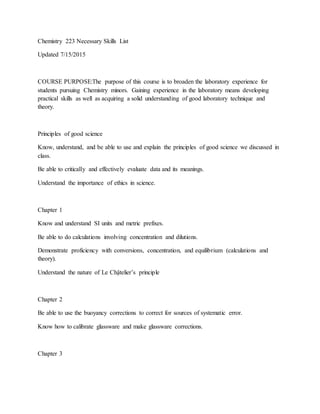
Necessary Skills List
- 1. Chemistry 223 Necessary Skills List Updated 7/15/2015 COURSE PURPOSE:The purpose of this course is to broaden the laboratory experience for students pursuing Chemistry minors. Gaining experience in the laboratory means developing practical skills as well as acquiring a solid understanding of good laboratory technique and theory. Principles of good science Know, understand, and be able to use and explain the principles of good science we discussed in class. Be able to critically and effectively evaluate data and its meanings. Understand the importance of ethics in science. Chapter 1 Know and understand SI units and metric prefixes. Be able to do calculations involving concentration and dilutions. Demonstrate proficiency with conversions, concentration, and equilibrium (calculations and theory). Understand the nature of Le Chậtelier’s principle Chapter 2 Be able to use the buoyancy corrections to correct for sources of systematic error. Know how to calibrate glassware and make glassware corrections. Chapter 3
- 2. Understand the procedures and philosophy for using sig figs in calculations (there is a practice worksheet posted in the easter egg area). Understand the concepts of and the differences in the ideas of precision and accuracy. Understand the different types of experimental error. Be able to do calculations for the propagation of uncertainty. Chapter 4 Understand the concept of a Gaussian distribution. Be able to use the statistical tools of mean and standard deviation (sample and population). Understand the meaning and be able to do calculations involving the other statistical tools: mean, standard deviation, Student’s t-tests, and Grubb’s tests, linear regression, and relative standard deviation. Understand the meaning of the concepts behind the terms of sy, sm, and sb. Chapter 6 Understand the concepts of equivalence point, end point, blank titration, titration error, blank titration, primary standard, standardization, direct titration, back titration, and indicator chemistry. Be able to do calculations involving solubility and Ksp. Chapter 8 Understand the relationship of [H+] and [OH-] in aqueous solutions of acids and bases. Understand equilibrium involving strong (and weak) acids and bases. Be able to do calculations involving pH for acids and bases both of which could be either strong and weak. Chapter 9
- 3. Learn and understand the nature of buffer solutions. Be able to do calculations involving buffered solutions. Understand conceptually the idea of buffer capacity Understand the limitations of the Henderson Hasselbalch equation. Chapter 10 Be able to do titration calculations for strong acid-strong base, weak acid-strong base, and strong acid-weak base. Be able to interpret the graph of a titration curve. Be able to determine the pH at any point during a titration. Chapter 11 Learn the nature of polyprotic acids and how to calculate pH of polyprotic acid solutions. Learn how to determine which form of a polyprotic acid is the principal species at a certain pH. Learn how to calculate the isoelectric point of a compound, and how this can be used to separate compounds. Chapter 13.1-13.3 Understand how EDTA interacts with metal ions. Understand the chemistry of metal ion indicators. Chapter 14.1-14.5 Know how to balance redox reactions Be able to recognize redox reactions and identify the process of reduction and oxidation, the terms oxidant vs. reductant, and oxidizing agent vs reducing agent Be able to write electrochemical reactions with line notation
- 4. Be able to draw a detailed schematic of a voltaic cell, be able to write electrochemical reactions, and determine the potential of that cell. Know how to use the Nernst equation to calculate non-standard conditions. Chapter 15 Understand the concept of a reference electrode in contrast to an indicator electrode. Learn the composition of both the SCE and the silver-silver chloride reference electrode. Understand and be able to explain the concept of a junction potential. Understand how a pH electrode works, and sources of potential errors Chapter 16.3 Learn the stoichiometry associated with iodometric titrations. Be able to do calculations of iodometric titrations. Chapter 18/19 Understand the wave nature of light. Understand how light and matter interact Understand Beer’s law, and be able to do calculations. Understand and be able to discuss the different parts of the spectrophotometers. Be able to do calculations of absorbance and transmittance. Understand the different ways that molecules absorb energy and relax when absorbing light. Know how to calculate the concentrations of components in a mixture from absorbance data. Chapter 20 Be able to discuss the difference between atomic absorption and atomic emission techniques.
- 5. Be able to explain the advantages and disadvantages of AA, GFAA, ICP, and ICP-MS. Chapter 21 Understand the principles of chromatography and separating chemicals. Understand and be able to describe the five types of chromatographic retention mechanisms that we discussed in class. Be able to read chromatograms, understand the concepts of theoretical plate height, number of the plates, resolution, retention, elution, and the van Deempter equation. Understand the fundamental sources of the broadening of bands in columns Understand and be able to explain the different types of parts that make up the main stages of a mass spectrometer. Understand the mass spectrum, and some of the interpretation tips and tricks we discussed in class. Be able to distinguish the advantages and disadvantages insofar as we discussed, of the different types of ionization techniques and mass analyzers. Chapter 22 Understand the basic inner workings of a gas chromatograph, from the inlet all the way to the different types of detectors, including different types of columns for the GC and the advantages and disadvantages of each. Be able to explain the advantages and disadvantages of temperature programming. Understand the basic operation and capabilities of the HPLC Learn how gradient elution can assist in HPLC analyses Chapter 23 Understand the principles of ion exchange Presentation, Ethics, and Data Analysis